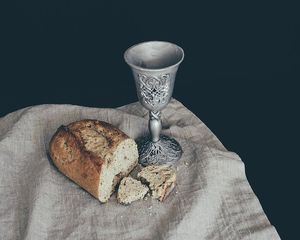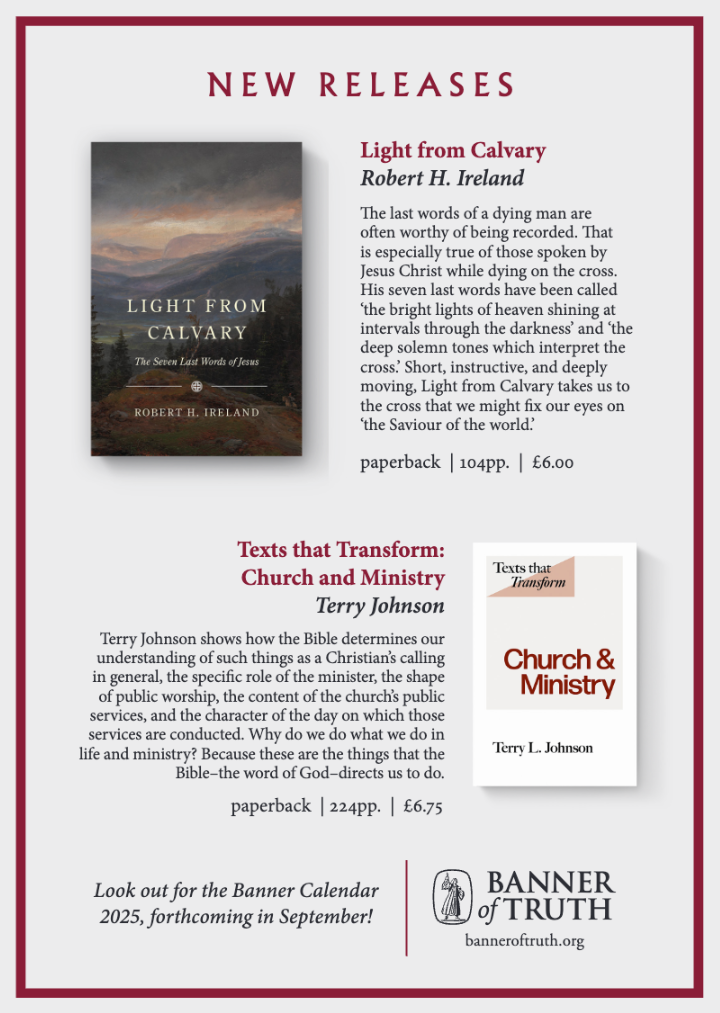The bread and wine are symbols of Christ’s flesh and blood. Sacramental use of these elements is a holy use of ordinary things and as such is to be conducted with the utmost reverence. Why? Because these symbols speak of Christ’s provision of redemption for his people.
1. Setting apart the elements — as the Lord did, with prayer — speaks of the setting apart of our Lord, from all eternity, to take our flesh and assume the office of Mediator between God and man.
2. Breaking the bread — as the Lord did before giving it to the disciples — provides a vivid picture of his body broken on the cross. It reminds us that, although death is the penalty for sin, his death is the sufficient payment for the sins of his people.
3. Pouring the wine — to put it in the cup — evokes the awful spectacle of the blood shed when they pierced his hands and feet and side. It elevates the intensity of his sacrifice for sin. Without the shedding of blood, there is no remission of sin (Hebrews 9:22).
4. Eating the bread and drinking the wine indicate both his gracious provision of salvation and our believing reception of that provision. These actions also represent the continuing promise of the Lord that he will continue to provide, that is, to be the author and finisher of our faith.
5. Eating and drinking together at the Lord’s Table emphasizes that believers are, together, in Christ; they are part of a corporate fellowship with Christ. At the Lord’s Supper, the church administers and celebrates its very character as the body of Christ and as a redeemed people. No one may stay home and be his own church, serving himself with his own sacrament.
6. The word of Christ precedes and accompanies the administration of the symbols of his sacrificial death. Together they declare afresh the will of Christ for our lives. We await the coming of the risen Christ. His death secures heaven for believers. His life guarantees the progress of the church in this world, until he comes at the end of the age.
The visible signs are seals of God’s promise
A seal pledges the validity and certainty of the things signified. It is a mark of authority. That is why we have such elaborate arrangements for such things as receipts, affidavits, certificates and diplomas. The symbols of the Lord’s Supper are pledges, firstly, of the validity of Christ’s death as an atonement for sin, and, secondly, of the certainty of his purpose of salvation for all who believe in him. Herman Hoeksema puts it thus: they are ‘as it were, the oath of God, which He will surely fulfill’.
A seal also presupposes something in the person to whom the sign is given. For example, the seal on a university degree diploma not only indicates the validity of the degree conferred, but testifies that the graduate has indeed fulfilled his commitments. Abraham received ‘the sign of circumcision’, which was also ‘a seal of the righteousness of the faith which he had while still uncircumcised…’ (Romans 4:11). So the signs of bread and wine are also seals of the faith already professed by those who come to communion. In coming to the Supper, communicants both profess faith and are confirmed in their faith. On the other hand, communing will do nothing for the unbeliever who dares to come forward, for he is in the condition of ‘not discerning the Lord’s body’. He will only incur greater guilt and judgement (1 Corinthians 11:27, 29).
The Lord’s Supper is only for confessing Christian believers, but it also speaks to non-participants who do not yet confess Christ. It calls them to come to him, the crucified, dead, buried and risen Saviour, that they too might have everlasting life. The Supper proclaims the gospel to the church and to the world; to believers; to their children; and to observers and enquirers alike.
The Lord’s Supper conveys the grace of Jesus Christ to believers as they faithfully participate. From Jesus’ standpoint, it is a sign and seal to believers of the efficacy of his atonement for them. From the believer’s standpoint, it is the proclamation of the Lord’s death — both a profession of faith from the heart, and a confirmation of faith to the heart.
Fisher’s Catechism
Two and a half centuries ago, a Scottish denomination called the Associate Presbytery (‘the Seceders’) published a catechism on the Westminster Assembly’s Shorter Catechism. This excellent work, called Fisher’s Catechism after one of its editors, James Fisher, beautifully explains and applies the point we have been discussing, as the following extracts show.
Q. What is it to show forth the death of Christ?
A. It is to profess [by partaking of this sacrament] that we believe his death, in our room, to have been most acceptable to God, Ephesians 5:2; and that we acquiesce therein, together with his obedience, is the sole ground of our hope of salvation, Romans 4:25.
Q. What is it about the death of Christ we ought to remember in the sacrament?
A. The truth of it: the necessity of it; and the sufficiency of it.
Q. What is it to remember the truth of Christ’s death?
A. It is by a true and saving faith, to believe that Christ really died and suffered all these things for us, that are recorded of him in Scripture, 1 Corinthians 15:3-4.
Q. What is it to remember the necessity of his death, Luke 24:26. ‘Ought not Christ to have suffered these things?’
Q. What is it to remember the sufficiency of it?
A. It is to believe that it is infinitely valuable: and therefore could have secured the salvation of thousands of worlds, had it been so ordained, it being the death and blood of him, who is the supreme God, Acts 20:28. — ‘Feed the church of God, which he hath purchased with his own blood.’
The visible signs speak of Christ’s death, constantly bringing us back to the foot of the cross and the ground of our salvation, and calling us to proclaim the victory of the risen Saviour over death and the grave. And all this to the end that we might grow in grace and that the world might hear the gospel of saving grace in Jesus Christ, Son of God and Saviour of the world.







